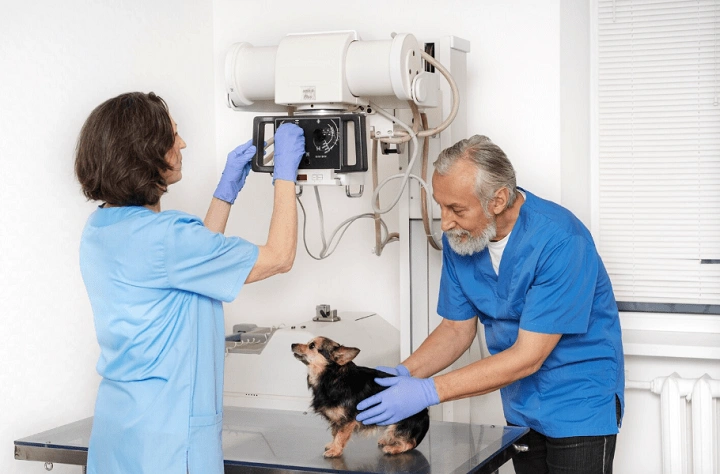According to recent surveys, over 70% of veterinary practices now use digital medical records, and more than 60% have integrated some form of telemedicine or remote consultation. Additionally, practices that adopt advanced diagnostic tools report a 30–40% improvement in patient care efficiency. These statistics highlight a clear trend: technology is no longer optional—it is essential for modern veterinary care. From improving diagnostics to streamlining operations, technological innovations are reshaping how veterinarians manage their practices and deliver care.
Digital Medical Records: A Game Changer
One of the most significant technological advancements in veterinary care is the widespread adoption of digital medical records. Gone are the days of cumbersome paper files and handwritten notes. Modern practice management software allows veterinarians to maintain comprehensive electronic medical records (EMRs) that are easily accessible and secure.
Digital records improve efficiency by enabling veterinarians to quickly retrieve a patient’s history, track vaccinations, manage lab results, and monitor ongoing treatments. They also facilitate better communication with pet owners through automated reminders for appointments, vaccinations, and follow-ups. Practices that implement EMRs often see enhanced client satisfaction and reduced administrative errors.
Advanced Diagnostic Tools
Technology has revolutionized veterinary diagnostics, allowing for faster and more accurate identification of health issues. Imaging tools such as digital radiography, ultrasound, and MRI have become more accessible to veterinary practices of all sizes. These technologies provide veterinarians with clear, detailed images that aid in the early detection of conditions such as fractures, tumors, and organ abnormalities.
Additionally, point-of-care diagnostic devices, such as portable blood analyzers, enable veterinarians to obtain results within minutes. This rapid diagnostic capability allows for timely treatment decisions, improving patient outcomes and reducing stress for both animals and owners. By investing in these advanced tools, veterinary practices can deliver higher-quality care while enhancing their reputation in the community.
Telemedicine and Remote Consultations
Telemedicine is another technological trend transforming veterinary practices. Virtual consultations allow veterinarians to reach clients who may have difficulty visiting the clinic, such as those living in remote areas or dealing with mobility challenges. Video consultations can be used for routine check-ins, follow-up appointments, and even preliminary assessments of new health concerns.
Telemedicine not only expands a practice’s reach but also improves client convenience and engagement. Many pet owners appreciate the flexibility of remote consultations, which can reduce stress for anxious pets who dislike trips to the clinic. For veterinary practices, integrating telemedicine can boost efficiency, allowing veterinarians to allocate in-clinic resources to cases that require hands-on care.
Automated Appointment Scheduling and Client Communication
Running a veterinary practice involves more than treating animals—it requires efficient management of appointments, staff, and client communication. Modern practice management software now includes automated scheduling, reminders, and client communication tools.
Automated systems help reduce no-shows, optimize staff schedules, and ensure clients receive timely information about their pets’ care. Many platforms also allow for two-way communication through text or email, making it easy for clients to ask questions or request appointments. By streamlining these administrative tasks, veterinary teams can focus more on patient care and less on time-consuming paperwork.
AI and Predictive Analytics
Artificial intelligence (AI) and predictive analytics are making their way into veterinary medicine, offering powerful tools for both patient care and practice management. AI algorithms can analyze medical data to detect patterns that may indicate underlying health problems before symptoms become apparent.
For example, AI can assist in diagnosing complex conditions such as heart disease or kidney dysfunction by analyzing lab results and imaging data. Predictive analytics also help practices forecast patient needs, optimize inventory, and identify opportunities for preventive care. Incorporating AI into veterinary practice allows for more proactive healthcare and data-driven decision-making, ultimately improving patient outcomes.
Wearable Technology for Pets
Wearable technology is no longer limited to human fitness trackers; pets are benefiting from these innovations as well. Devices such as GPS collars and activity monitors provide valuable data about an animal’s location, activity levels, and overall health.
Veterinarians can use this information to monitor chronic conditions, track recovery after surgery, and provide personalized care recommendations. Pet owners gain peace of mind knowing they can keep tabs on their animals’ health in real-time. Wearable technology also strengthens the bond between veterinarians and clients by offering data-driven insights that support proactive health management.
Enhanced Surgical and Treatment Techniques
Technology is also transforming surgical and treatment procedures in veterinary medicine. Modern operating rooms are equipped with advanced anesthesia monitoring systems, surgical lasers, and minimally invasive equipment. These tools reduce surgical risks, speed up recovery, and improve outcomes for patients.
Robotics and precision-guided surgery, although still emerging in veterinary practice, are beginning to offer veterinarians enhanced control and accuracy during complex procedures. These technological advancements not only improve patient safety but also elevate the quality of care offered by practices willing to invest in cutting-edge treatment solutions.
Financial and Operational Management Tools
Running a successful veterinary practice requires careful financial management and operational oversight. Technology has introduced software solutions that handle billing, inventory management, payroll, and even marketing. These platforms provide veterinarians with real-time insights into their practice’s performance, enabling data-driven decisions that promote growth and efficiency. For practices considering expansion or vet practice sales, these management tools are invaluable, offering a clear view of financial health and operational performance. With accurate reporting and analytics, veterinarians can make informed decisions about staffing, investment in new equipment, and service offerings.
Conclusion
Technology is transforming veterinary practices in profound ways, from improving patient care and diagnostics to streamlining operations and client engagement. Digital medical records, advanced diagnostic tools, telemedicine, AI, wearable devices, and modern surgical techniques are all redefining what a veterinary practice can achieve.
Embracing these innovations allows veterinarians to provide higher-quality care, enhance client satisfaction, and operate more efficiently. As the veterinary field continues to evolve, practices that integrate technology thoughtfully will not only thrive but also set new standards in animal healthcare. For modern veterinary professionals, technology is no longer just a support tool—it is a cornerstone of practice success.



